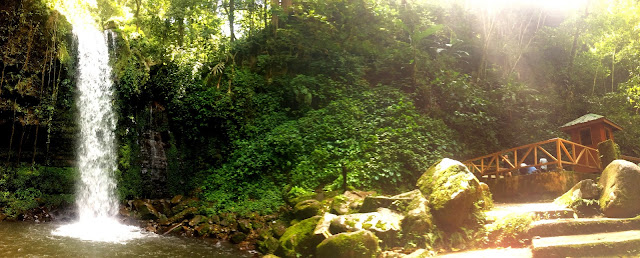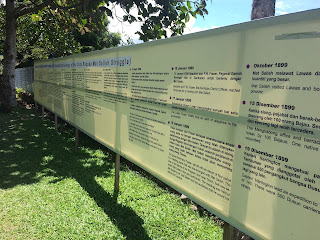So we head down to Keningau Town again to hunt for Laksa that we missed yesterday. Out of no one we know lives here, we randomly walked into a Chinese religious supplies shop and asked the owner to recommend a must-eat food in Keningau. He pointed us to the corner of the shoplot which sells Laksa - 阿川叻沙kopitiam. Unfortunately the famous Laksa was sold out yesterday so we ordered kuey chap (mixed pork internal parts noodle in dark bak-kut-teh-like soup base). This morning we ordered Sarawak Laksa - the taste for both were good. I just ate kuey chap noodles except for the parts, and I enjoyed the laksa very much. I should have tried the water dumpling instead of shrimp.
(Left) Kuey Chap (Right) Sarawak Laksa
Keningau word came from local word "Koningau" means cinnamon or Kayu Manis in Malay. You can find many stalls in Wet Market sell cinnamon sticks. One bundle like picture above is sold at RM10. It's mainly use as spice and some use it for decoration.
Dried salted fish
The old 大伯公temple. The staff said it wasn't over 100 years old yet. Nothing much info I could obtain from the temple as the staff wasn't a Chinese and couldn't share much of its history with me. However the interior is typical to most of the Chinese temples in Malaysia. They also celebrate birthday of different deities, significant persons, Taoism deities prayers, Chinese traditional festivals and so on, to keep Chinese in the town together.
Forrest was attracted by this giant laughing Buddha while we were having breakfast next to this temple.
Next we visited Keningau Heritage Museum. This building was formerly known as the Residence House to accommodate dignitaries and foreign visitors. It then used by the Japanese and British North Borneo Chartered Company until it was taken over by the State government.
The first section on the left exhibits the excavation activities done in Tapak Bingkor, Keningau region.
There're many antique collections displayed in the hall. These items are the collections donated by Sir Andrew Bacon and his wife Jane Sakunil.
These pots or locally known as 'tajau' have some stories behind. It was first owned by the grandfather of Datuk Clement Jaikul, Sargent Imbayan Andoung from Kg. Nambayan. He passed these pots to his son, Datuk Stephen Jaikul Imbayan then Datuk Clement Jaikul before it's handed over to Sabah Museum Department.
These pots were used to be placed together with 30 human skulls collected by Datuk Clement Jaikul's grandfather during the headhunting time. When Datuk Clement brought these pots back to his house at Kota Kinabalu, his 7-year-old son saw some human beings nearby these pots. Then he fell sick the next day. In another incident, a teenage girl fainted suddenly when she saw a thin woman shadow coming out from the pot when Datuk Clement was hosting a gathering at his house. Since these incidents happened, Datuk Clement decided to bring these pots back to his hometown in Tambunan. While on his way from Kota Kinabalu to Tambunan, his car suddenly stopped and the engine can't be started. So at the end of the day, Datuk Clement handed over these two pots to Sabah Museum Department on 25 July 2013, which are now being displayed at Keningau Heritage Museum.




The items displayed above tell history of Keningau under Japanese occupation and how Australian army liberated Keningau. The Royal Australian Air Force (RAAF) from 76 and 77 Squadron bombed Japanese positions in Keningau until the end of hostilities, when Japanese surrendered in 1945. Then the Australians kept Keningau up and running by supplying daily necessities to the inbahitants such as food, clothes and medical supplies when North Borneo was placed under the British Military Administration (BMA). When Malaysia came into being on 16 September 1963, Sukarno launched an undeclared war on the newly created federation known as the Indonesian Confrontation. The Australian government defended Borneo including Keningau.

The Oath Stone, erected in front of the Keningau District Office in 1964, was planted to symbolise the Interior people's acceptance of Malaysia, when the new nation was created in 1963. The stone was obtained from the Pegalan River in the vicinity of Kampong Senegang. As the Interior native people accepted Malaysia, it means that their interests of land, religion and customs will be safeguarded by the Federal Government in the spirit of the Twenty Points.
To be continued.




















